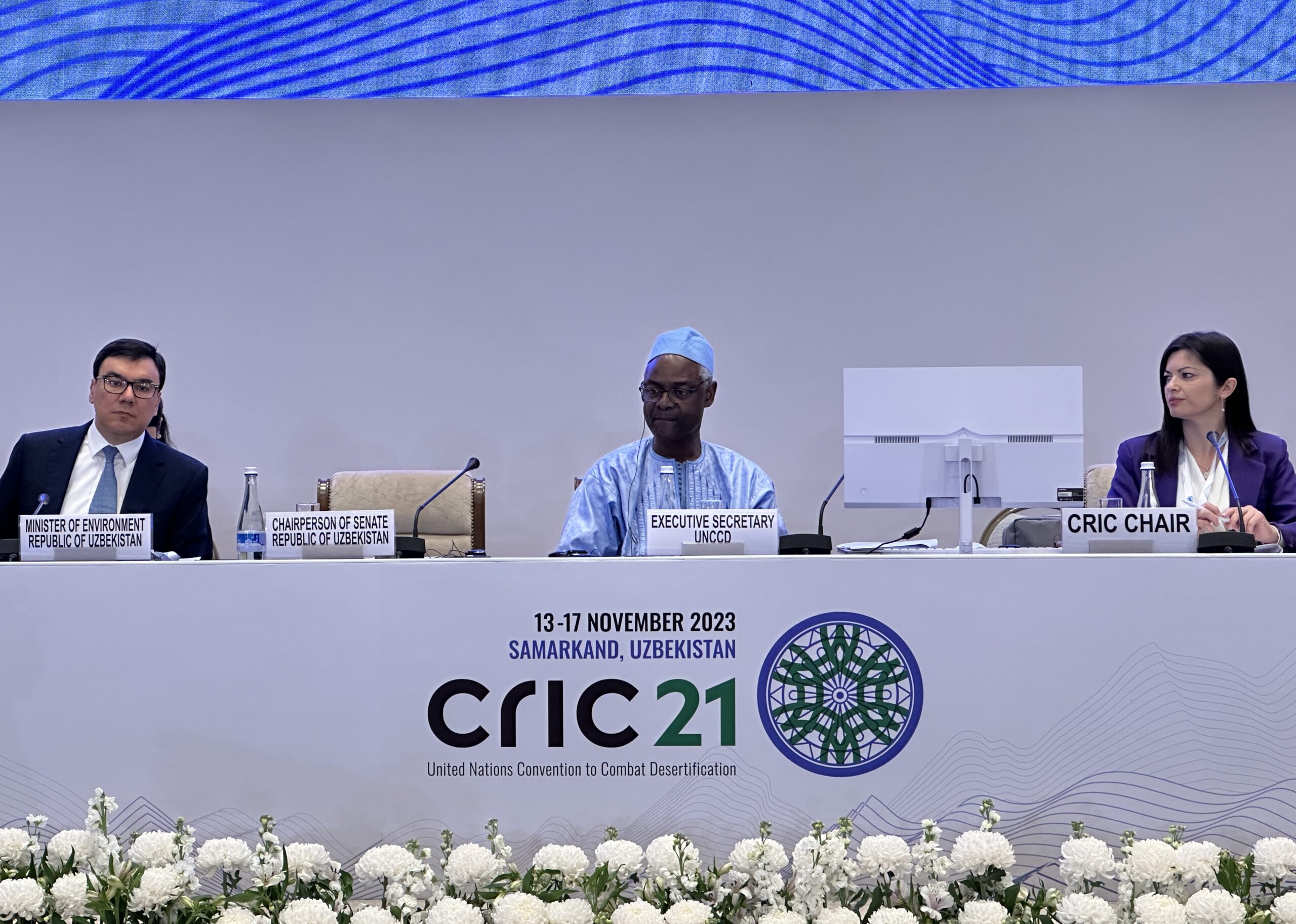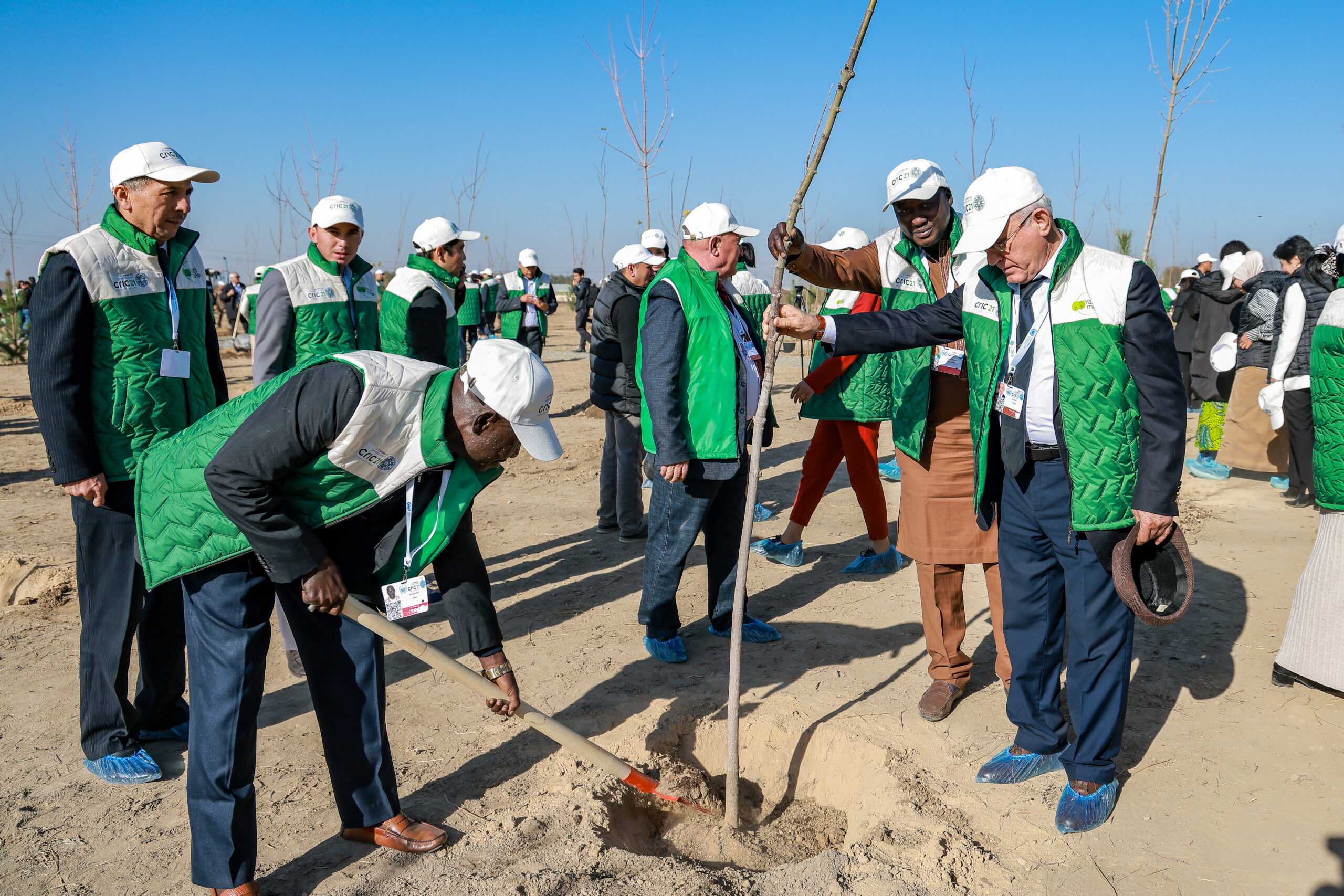SAMARKAND – With 100 million hectares of land degraded every year, it is time to measure the pulse of the planet, said Ibrahim Thiaw, the Under-Secretary-General and Executive Secretary of the United Nations Convention to Combat Desertification (UNCCD) at the opening of the 21st session of the UNCCD Committee on the Review of the Implementation of the Convention (CRIC21) on Nov. 13 in Samarkand, Uzbekistan.

Uzbek Minister of Ecology, Environmental Protection and Climate Change Aziz Abdukhakimov, UNCCD Executive Secretary Ibrahim Thiaw and CRIC Chair Biljana Kilibarda. Photo credit: astanatimes.com
For countless generations, the land was the source of life that provided traditional communities with food and water but the quest for progress and prosperity “have inflicted the ugliest scars on the face of our Earth,” said Thiaw.
The recently launched UNCCD Data Dashboard compiling national reports from 126 countries shows that desertification is progressing fast.
“While this work is still to be perfected, the early indications gave us chilling numbers: at least 100 million hectares of land are degraded every year,” said Thiaw.
Ahead of the UNCCD’s 16th Conference of Parties (COP16) in Saudi Arabia next year, the CRIC21 would serve as a “stepping stone between COP15 in Abidjan and COP16 in Riyadh,” he said.
“Time to assess how much of our lives we have degraded, how much of our economy we have destroyed, knowingly or unknowingly, willingly or unwillingly. Time to appreciate how sustainable – or rather unsustainable – our lifestyle is. Time to check how much of our children’s reserves and shares we are eating, how much of our grandchildren’s future we are jeopardizing by over-harvesting, and overexploiting our natural capital,” said Thiaw.
Green initiatives
“It is not by accident that CRIC21 is hosted in Uzbekistan, as it is an example of one of the most vulnerable countries, which is experiencing all negative consequences of land degradation: from increasing droughts, sand and dust storms to the loss of agricultural productivity and biodiversity,” said Aziz Abdukhakimov, the Uzbek Minister of Ecology, Environmental Protection, and Climate Change at the opening of the CRIC21.

1,000 trees were planted by delegations as part of the CRIC21. Photo credit: eco.gov.uz
According to the minister, the results of the Uzbek government’s efforts to tackle land degradation can be seen in the Yashil Makon (Green Oasis) project launched in 2021 at the initiative of Uzbek President Shavkat Mirziyoev. The project aims to plant 200 million seedlings of trees and shrubs annually and to increase green areas in cities to 30% by 2030.
“Since the launch of this initiative more than 416 million trees and shrubs were planted across the country,” said Abdukhakimov.
Green gardens were planted on 588 hectares and 662 hectares were used to create green public areas. Green belts with a total length of 40 kilometers were planted around the most vulnerable cities such as Bukhara, Nukus, Khiva and Urgench.
Continuing the Yashil Makon tradition, 1,000 tree saplings were planted by delegations in the Green Park CRIC21 – a zone near Samarkand that covers an area of 2.5 hectares on Nov. 13.
Aral Sea and dust storms
The impacts of land degradation – sand and dust storms – are evident in Central Asia, said the Uzbek minister.
“Just a few months ago, I was on a trip to Kazakhstan witnessing a dust storm. Upon my return to Uzbekistan, this dust storm was already in Tashkent spreading over to other neighboring countries,” Abdukhakimov said.
“This shows that Central Asia is one ecosystem and only by uniting our efforts and collectively addressing environmental challenges we will be able to achieve some tangible results. As such, strengthening regional cooperation in combating climate change is one of the key priorities for Uzbekistan,” added Abdukhakimov.
“The Aral Sea region records exceptionally high rates of dust storms with an annual volume of 100 million tons and reaching up to 1,000 kilometers. The drying up of the Aral Sea, the reduction in the flow of major rivers, the degradation of ecosystems, the loss of biodiversity and desertification are among the main problems not only for Uzbekistan but for the Central Asian region as a whole,” said Abdukhakimov.
He also highlighted Uzbekistan’s efforts in preventing the spread of dust storms from the Aral Sea.
“Under the leadership of the President of the Republic of Uzbekistan Shavkat Mirziyoyev, massive afforestation campaigns launched at the drained bottom of the Aral Sea, covering an area of over two million hectares with the main aim to prevent dust and salt storms. The economic and social situation in the Aral Sea region has been improved,” Abdukhakimov said.

